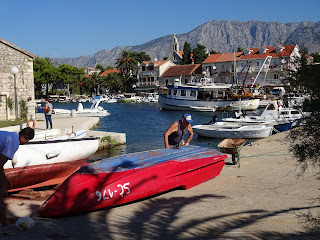Croatia has many coastal islands; in a two-week sojourn, we only had time to sample a few locations. We drove south to the city of Split, passing by Zadar, Krka National Park and a host of other interesting places. Split is not just a tourist destination, but an important commercial and transportation center. As such, it is quite congested (did I see smog?); we were glad for the GPS in locating our B&B and parking the car. We were able to walk to the harbor to get a ferry ticket for the following day, visit Diocletian's palace (a Roman emperor who lived over 1700 years ago), and then walk to the oceanfront beach and find a recommended restaurant. Our server was super; a man of about 50 y.o., who seemed to know every ingredient of every item they served, he understood my lactose condition and was able to quickly suggest alternate ingredients. Throughout the region we found that servers and chefs were ready to alter any recipe for our individual needs. A great dinner served outdoors on a patio elevated on a low cliff overlooking sunset on the ocean; this is what vacations are for.
The yacht "A" at anchor off of Split. This yacht travels the world, and it is said that the Russian owner is building a larger sailing yacht.
The quiet cove where our hotel was located. We were away from the congestion of downtown; our hotel had a small restaurant (with excellent meal options) right on the beach.
Sunset at Hvar. A cruise ship leaving harbor, and local boats tidying up for the night.
The ferry to Hvar was uneventful, other than spotting a world-famous yacht, "A", built at a cost of $300 million by a Russian billionaire. The town of Hvar is located on the island of Hvar. The island is a wine-growing center; the town is a yachting center. Overlooking the city is a fortress which provided protection for the citizens when the Ottoman fleet stopped here on its way to the Battle of Lepanto in 1571 (historic battle between Christians and Muslims for control of the Mediterranean). The town is scenic, accentuated by beautiful yachts and a long promenade to view them from. We drove the length of the island to Sucura and took a shorter ferry ride back to the mainland.
History is everywhere in this region. Why do you drive through a narrow bit of Bosnia-Herzegovina dividing Croatia as you drive toward Dubrovnik? Because of a treaty signed centuries ago. Dubrovnik was bordered by the Ottoman Empire to the south and threatened by the city-state of Venice to the north. Solution: grant a piece of land north of the city to the Ottomans so an attack from the north would challenge the Ottomans before reaching Dubrovnik.
After passing through the Bosnia corridor, we stopped in the village of Mali Ston for lunch. The village is unimpressive at first appearance, but the restaurant and bay view were excellent. Nearby is a massive wall across the Peljesac peninsula worth viewing.








No comments:
Post a Comment